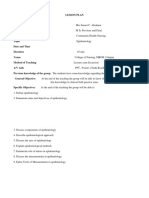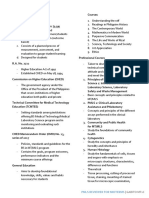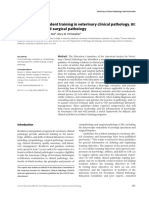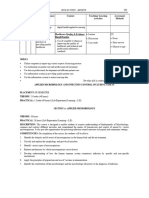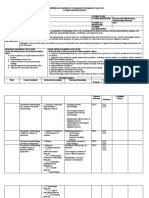0 ratings0% found this document useful (0 votes)
83 viewsLesson 5: Medical Technology Education: Definition of Curriculum
Lesson 5: Medical Technology Education: Definition of Curriculum
Uploaded by
AnyhaThis document outlines the curriculum for a Bachelor of Science in Medical Technology/Medical Laboratory Science (BSMT/BSMLS). It discusses the definition of curriculum and key aspects of the BSMT/BSMLS program such as it being a 4-year allied health program consisting of general education courses and professional courses. The professional courses include subjects like clinical bacteriology, immunohematology, and medical parasitology. The curriculum is guided by the Commission on Higher Education and aims to develop students' knowledge and technical skills needed for a career in medical laboratory science.
Copyright:
© All Rights Reserved
Available Formats
Download as DOCX, PDF, TXT or read online from Scribd
Lesson 5: Medical Technology Education: Definition of Curriculum
Lesson 5: Medical Technology Education: Definition of Curriculum
Uploaded by
Anyha0 ratings0% found this document useful (0 votes)
83 views4 pagesThis document outlines the curriculum for a Bachelor of Science in Medical Technology/Medical Laboratory Science (BSMT/BSMLS). It discusses the definition of curriculum and key aspects of the BSMT/BSMLS program such as it being a 4-year allied health program consisting of general education courses and professional courses. The professional courses include subjects like clinical bacteriology, immunohematology, and medical parasitology. The curriculum is guided by the Commission on Higher Education and aims to develop students' knowledge and technical skills needed for a career in medical laboratory science.
Original Title
lesson 5
Copyright
© © All Rights Reserved
Available Formats
DOCX, PDF, TXT or read online from Scribd
Share this document
Did you find this document useful?
Is this content inappropriate?
This document outlines the curriculum for a Bachelor of Science in Medical Technology/Medical Laboratory Science (BSMT/BSMLS). It discusses the definition of curriculum and key aspects of the BSMT/BSMLS program such as it being a 4-year allied health program consisting of general education courses and professional courses. The professional courses include subjects like clinical bacteriology, immunohematology, and medical parasitology. The curriculum is guided by the Commission on Higher Education and aims to develop students' knowledge and technical skills needed for a career in medical laboratory science.
Copyright:
© All Rights Reserved
Available Formats
Download as DOCX, PDF, TXT or read online from Scribd
Download as docx, pdf, or txt
0 ratings0% found this document useful (0 votes)
83 views4 pagesLesson 5: Medical Technology Education: Definition of Curriculum
Lesson 5: Medical Technology Education: Definition of Curriculum
Uploaded by
AnyhaThis document outlines the curriculum for a Bachelor of Science in Medical Technology/Medical Laboratory Science (BSMT/BSMLS). It discusses the definition of curriculum and key aspects of the BSMT/BSMLS program such as it being a 4-year allied health program consisting of general education courses and professional courses. The professional courses include subjects like clinical bacteriology, immunohematology, and medical parasitology. The curriculum is guided by the Commission on Higher Education and aims to develop students' knowledge and technical skills needed for a career in medical laboratory science.
Copyright:
© All Rights Reserved
Available Formats
Download as DOCX, PDF, TXT or read online from Scribd
Download as docx, pdf, or txt
You are on page 1of 4
Lesson 5: Medical Technology Education
Lecture Notes M1.5
Definition of Curriculum
a. Latin word “currere” means to run Composed of leading academicians and
b. The knowledge and skills students are expected practitioners
to learn Set the standards among institutions offering
c. The means and materials with which students BSMT/BSMLS and in monitoring and
interact for the purpose of achieving identified evaluating them
educational outcomes.
d. The continuous reconstruction, moving from the BSMT/BSMLS
child’s present experience out into that
represented by the organized bodies of truth that An allied health programs
we call studies (John Dewy) 4-year program; 3 years of GE and professional
e. Planned interaction of students with the courses and 1 year of internship training
instructional content, materials, resources, and
processes for evaluating the attainment of CHED Memorandum Order (CMO) No. 13 of 2017
educational objectives (Indiana Department of
A guide for institutions offering BSMT/BSMLS
Education).
Contains goals, program outcomes, performance
Looking into these definitions, curriculum: indicators, and the minimum course offerings
1 unit = 1 hour, 3 units = 3 hours per week, 54
a. Is systematic and organized; hours per semester = 18 weeks
b. Explicitly states outcomes (knowledge,
skills) the learners/students have to achieve General Education (GE) Courses
and learn through the use of planned
instructional processes and other learning Aim to develop humane individuals that have a
implements in a specific period; deeper sense of self and acceptance of others
c. Consists of a planned process of Aim to develop foundational knowledge, skills,
measurement, assessment, and evaluation to values, and habits necessary
gauge student learning; and
Professional Courses
d. Is designed for students.
1. Principles of Medical Laboratory Science 1
Curriculum, practice of the profession,
clinical laboratory, continuing
professional education, biosafety
Medical Technology Curriculum practices, and waste management
2. Principles of Medical Laboratory Science 2
Commission on Higher Education (CHED) May 18, Phlebotomy deals with the basic
1994 concepts, principles, and application of
the standard procedures in blood,
Republic Act no. 7722 collection, transport, and processing
Under the Office of the President of the Study of pre-analytic, analytic, and post-
Philippines analytic variables
Covers public and private college institutions
3. Community and Public Health for MT/MLS
Technical Committee for Medical Technology Education
The promotion of community, public,
(TCMTE)
and environmental health and the
immersion and interaction of students
Lesson 5: Medical Technology Education
Lecture Notes M1.5
Human ecology, demography, and Performing different
epidemiology biochemical tests for
identification of bacteria
4. Cytogenetics Preparation of culture media
The analysis of nuclei acids and their Collection of specimens
application to medical science Preparation of bacterial smear,
Concepts and principles of hereditary staining of smear
and inheritance (genetic phenomena, sex Inoculation of specimen on
determination and genetic defects rooted culture media
in inheritance) Characterization of colonies of
Abnormalities and genetic disorder bacteria growing in culture
media
Biosafety and waste
management
Quality assurance and quality
5. Human Histology control
Microscopic identification and Antimicrobial susceptibility
differentiation of cells testing
Study of fundamental of cells, tissues,
and organs (microscopic structures, 8. Clinical Parasitology
characteristics, differences, and Pathophysiology, epidemiology, life
functions) cycle, prevention and control, and the
identification of ova and/or adult worms
6. Histopathologic Techniques with Cytology and other forms seen in specimens
Basic concepts and principles of disease submitted for diagnostic purposes
processes, etiology, and the Study of animal parasites in human and
development of anatomic, microscopic their medical significance
structures, characteristics, differences, Microscopic identification of
and functions diagnostic features of different
Preparation of tissue samples for group of parasites pathogenic to
microscopic examinations for diagnostic man
purposes Different methods of preparing
smear for microscopic
Perform for the laboratory by the students: examination
Tissue processing
Mounting of stained tissue for 9. Immunohematology and Blood Bank
microscopic examination Inheritance, characterization, and
Staining laboratory identification of red cells
Cutting of processed tissue antigens and their corresponding
Performing biosafety and waste antibodies
management The app of these antigens and/or
antibodies in transfusion medicine and
7. Clinical Bacteriology transfusion reactions work-up
The collection of specimens and the Perform for the laboratory by students:
isolation and identification of bacteria
Study of physiology and morphology of ABO and Rh typing
bacteria and their role in infection and Coombs test (direct and indirect)
immunity Blood donation process
Antimicrobial susceptibility testing and Compatibility testing
development of resistance Transfusion reaction work-up
Preparation of RBC suspension
Lesson 5: Medical Technology Education
Lecture Notes M1.5
Quality assurance and quality
control
10. Mycology and Virology Biosafety and waste
Study of fungi and viruses as agents of management
diseases with emphasis on
epidemiology, laboratory identification 14. Hematology 2
and characterization, and prevention and
Concepts and principles of hemostasis,
control.
and abnormalities involving RBC,
WBC, and platelets
11. Laboratory Management Laboratory identification of blood cell
Planning, organizing, staffing, directing, abnormalities, quantitative measurement
and controlling as applied in clinical of coagulation factors, and disease
laboratory setting correlation are emphasized
Process of solving problems, quality Identification of abnormal RBC
assurance and quality control, and WBC
preparation of policy and procedure Special staining techniques
manuals, and other activities necessary Coagulation factor test
to maintain a well-functioning Instrumentation
laboratory
15. Clinical Microscopy
12. Medical Technology Law and Bioethics Study of urine and other body fluids
Various laws, administrative orders, and (excluding blood)
other approved legal documents Formation, laboratory analyses, disease
Study of ethics as applied to health and processes, and clinical correlation of
health care delivery and to human life in laboratory results
general Routine urinalysis
Special chemical examination of
13. Hematology 1 urine
Study of the concepts of blood as a Examination of other body
tissue fluids
Formation of cells, lab assays, Pregnancy tests
correlation with pathologic conditions, Chemical examination of stool
special hematology evaluation are given specimen
emphasis
Quality assurance and quality control in 16. Clinical Chemistry 1
in the laboratory Concepts and principles of
Bone marrow studies physiologically active soluble
Complete Blood Count (CBC) substances and waste materials in the
Hematocrit blood test body fluids
Platelet count Formation, laboratory analyses,
Preparation of smear and reference values and clinical correlation
staining with pathologic conditions
Red cell morphology Instrumentation
Erythrocyte sedimentation rate Quality assurance and quality
(ESR) control
Fragility test Glucose determination
Erythrocyte indices Lipid testing
Reticulocyte count Renal function tests
Instrumentation Protein testing
Osmotic fragility test Biosafety and waste
management
Lesson 5: Medical Technology Education
Lecture Notes M1.5
17. Clinical Chemistry 2
Concepts and principles of
physiologically active soluble
substances and waste material present in
body fluids
Endocrine glands and hormones, and
their formation, laboratory analyses, and
clinical correlation
Therapeutic drug monitoring and
laboratory analyses of drugs and abused
substances, also toxic substances
Bilirubin tests
Clinical enzymology
Electrolyte testing
Drug tests
18. Seminars 1 and 2
4th year in the program goes with the
internship training
Deals with current laboratory analyses
used in medical technology practices
19. Molecular Biology and Diagnostics
Nucleic acid and protein molecule
interaction within the cell
The molecular mechanisms of DNA
replication, repair, transcription,
translation, protein synthesis, and
regulation
Application of different molecular
techniques as tools in the diagnosis
Polymerase Chain Reaction (PRC)
Research Course
You might also like
- Pmls Notes (Lesson 5)Document5 pagesPmls Notes (Lesson 5)Eloisa LourdesNo ratings yet
- PMLS Reviewer For Midterms PDFDocument14 pagesPMLS Reviewer For Midterms PDFJerica Mae Gabito100% (1)
- Lesson Plan EpidemioDocument6 pagesLesson Plan Epidemiorocky100% (3)
- NCM 106 - PharmacologyDocument7 pagesNCM 106 - PharmacologyChelleyOllitro100% (4)
- Logbook &laboratory Work Guide of Medical Microbiology and ImmunologyDocument36 pagesLogbook &laboratory Work Guide of Medical Microbiology and ImmunologyrehanaNo ratings yet
- PMLS - Curriculum Medical TechnologyDocument3 pagesPMLS - Curriculum Medical TechnologyCharisse ParcellanoNo ratings yet
- PMLS Lesson 5Document4 pagesPMLS Lesson 5Mi ReiNo ratings yet
- PMLS L4Document8 pagesPMLS L4seaynNo ratings yet
- Medical Technology ReviewerDocument5 pagesMedical Technology ReviewerSheyn Mahru ConomanNo ratings yet
- PMLS 1 p4Document8 pagesPMLS 1 p4anthonyNo ratings yet
- Definition of CurriculumDocument11 pagesDefinition of CurriculumZabdiel Ann SavellanoNo ratings yet
- PMLS 1Document14 pagesPMLS 1AelwenNo ratings yet
- Medtech EduDocument3 pagesMedtech Eduevan vidanesNo ratings yet
- Topic 4Document13 pagesTopic 4Alsaief MuallipNo ratings yet
- UNIT 3.0 Medical Technology CurriculumDocument12 pagesUNIT 3.0 Medical Technology CurriculumJean Carmelette BalalloNo ratings yet
- Study PlanDocument2 pagesStudy Planobidovodiljon68No ratings yet
- PMLS Lesson 5Document7 pagesPMLS Lesson 5Althea EspirituNo ratings yet
- Medical CurriculumDocument7 pagesMedical Curriculumdaffny10No ratings yet
- Transes PmlsDocument9 pagesTranses PmlsbelarminoreychellelynNo ratings yet
- Pafp Foundation Courses: Instructional DesignDocument12 pagesPafp Foundation Courses: Instructional DesignZaqueo Gutierrez Fajardo100% (1)
- Guidelines Citopathology 2009Document7 pagesGuidelines Citopathology 2009Fabrício CamargoNo ratings yet
- PMLS Chapter 5 SummaryDocument5 pagesPMLS Chapter 5 SummaryKisen DiazNo ratings yet
- BeInPM EMJMDs Educational ProgrammeDocument8 pagesBeInPM EMJMDs Educational ProgrammeNabielaNo ratings yet
- Microbiology Parasitology OBE Syllabus Final 1Document16 pagesMicrobiology Parasitology OBE Syllabus Final 1Ryzette Angela MorañaNo ratings yet
- 2023 MD AnatomyDocument23 pages2023 MD AnatomySuraj SahooNo ratings yet
- MD Human Anatomy (Revised)Document25 pagesMD Human Anatomy (Revised)VJNo ratings yet
- College of Health Science syllabusDocument20 pagesCollege of Health Science syllabusFacts TVNo ratings yet
- Open Letter From Chinese HIV Professionals On HumaDocument2 pagesOpen Letter From Chinese HIV Professionals On HumatsablalaNo ratings yet
- Ched Memorandum Order No.13 Series of 2017 PDFDocument7 pagesChed Memorandum Order No.13 Series of 2017 PDFacademics pdfNo ratings yet
- 3rd Sem SyllabusDocument23 pages3rd Sem SyllabusTopeshwar TpkNo ratings yet
- Para Lec CS 2022 2023Document10 pagesPara Lec CS 2022 2023Arienda RKNo ratings yet
- Medical GeneticsDocument44 pagesMedical GeneticsScribdTranslationsNo ratings yet
- MD AnatomyDocument16 pagesMD AnatomyJaydenNo ratings yet
- Combine PGDMLT Syllabus FinalDocument49 pagesCombine PGDMLT Syllabus Finalu713607No ratings yet
- Diploma Clinical PathologyDocument12 pagesDiploma Clinical Pathologyanilrockzzz786No ratings yet
- Animal Breeding and Reproduction Biotechnology: Organized by Mediterranean Agronomic Institute of ZaragozaDocument11 pagesAnimal Breeding and Reproduction Biotechnology: Organized by Mediterranean Agronomic Institute of ZaragozaMalik ZrgulNo ratings yet
- BTCH 1 Learning ModuleDocument33 pagesBTCH 1 Learning ModuleLOURDES W. UMILNo ratings yet
- 1 - Pharmaceutical Biotechnology. Lecture One.Document42 pages1 - Pharmaceutical Biotechnology. Lecture One.konouzabousetta2021No ratings yet
- Practice of Medical Technology ProfessionDocument3 pagesPractice of Medical Technology ProfessionMARY GLORY IGNACIONo ratings yet
- Course Syllabus - General MicrobiologyDocument3 pagesCourse Syllabus - General MicrobiologyTristan BabaylanNo ratings yet
- SyllabusDocument81 pagesSyllabusMohammed Aijaz AliNo ratings yet
- Community Nursing StandardsDocument14 pagesCommunity Nursing StandardsScribdTranslationsNo ratings yet
- Biostatistics and Epidemiology Syllabus-1Document7 pagesBiostatistics and Epidemiology Syllabus-1Dehnzel de Leon100% (1)
- Microbiology and ParasitologyDocument5 pagesMicrobiology and ParasitologyChester Riogelon100% (2)
- Course PlanDocument9 pagesCourse Planmanaswi debbarmaNo ratings yet
- A Laboratory Manual For BIOCHEMISTRY AND PDFDocument59 pagesA Laboratory Manual For BIOCHEMISTRY AND PDFArdelean DanNo ratings yet
- To Assess The Knowledge, Level of Awareness, And.3Document7 pagesTo Assess The Knowledge, Level of Awareness, And.3reynald susbillaNo ratings yet
- Humanure PortugueseDocument23 pagesHumanure PortuguesepatmesquitaNo ratings yet
- Силлабус ДВ 2023-2024 АнгDocument24 pagesСиллабус ДВ 2023-2024 АнгMaimuna MarshedNo ratings yet
- 003 - Microbiology Fellowship Module MICRO 111 March 12Document7 pages003 - Microbiology Fellowship Module MICRO 111 March 12Troy LanzaderasNo ratings yet
- PUBH 600: Concepts and Methods of Epidemiology: Department of Public Health - Fall 2022Document15 pagesPUBH 600: Concepts and Methods of Epidemiology: Department of Public Health - Fall 2022Ala'a MassarwehNo ratings yet
- SAC Review: Omic' Technologies: Genomics, Transcriptomics, Proteomics and MetabolomicsDocument7 pagesSAC Review: Omic' Technologies: Genomics, Transcriptomics, Proteomics and MetabolomicsandreaNo ratings yet
- BiopharmaceuticalsDocument6 pagesBiopharmaceuticalsNikko Nabasca GorneNo ratings yet
- Biochemistry PDFDocument28 pagesBiochemistry PDFReekBhattacharyaNo ratings yet
- Topic 5. MEDICAL TECHNOLOGY EDUCATIONDocument7 pagesTopic 5. MEDICAL TECHNOLOGY EDUCATIONSophia GarciaNo ratings yet
- Guidance On Good Cell Culture PracticeDocument27 pagesGuidance On Good Cell Culture PracticeFalopaNo ratings yet
- Incorporating Bioethics Education into School CurriculumsFrom EverandIncorporating Bioethics Education into School CurriculumsNo ratings yet
- Encyclopedia of Infectious Diseases: Modern MethodologiesFrom EverandEncyclopedia of Infectious Diseases: Modern MethodologiesMichel TibayrencNo ratings yet
- The Human Microbiota: How Microbial Communities Affect Health and DiseaseFrom EverandThe Human Microbiota: How Microbial Communities Affect Health and DiseaseRating: 3.5 out of 5 stars3.5/5 (6)
- DR Noman Bin AbidDocument5 pagesDR Noman Bin Abidrov aroundNo ratings yet
- 11th Bio-Zoo & Zoo EM.Document35 pages11th Bio-Zoo & Zoo EM.shansri505No ratings yet
- Share Chap 3 - Trypanosomiasis - T BruceiDocument24 pagesShare Chap 3 - Trypanosomiasis - T BruceiTalya DannawiNo ratings yet
- MicroscopeDocument19 pagesMicroscopeHarini ThiruNo ratings yet
- AAGP2 enDocument3 pagesAAGP2 enLince WijoyoNo ratings yet
- Flags in Sysmex Xe 5000Document8 pagesFlags in Sysmex Xe 5000Prosenjit Roy ChoudhuryNo ratings yet
- Design, Synthesis and Biological Evaluation of Pyrido (2,3-d) Pyrimidin-7 - (8H) - Ones PDFDocument21 pagesDesign, Synthesis and Biological Evaluation of Pyrido (2,3-d) Pyrimidin-7 - (8H) - Ones PDFMiguelAlejandroMantaChavezNo ratings yet
- DNA and RNA Viruses Replication-NewDocument48 pagesDNA and RNA Viruses Replication-NewKwirimeNo ratings yet
- Micropara HomeworkDocument4 pagesMicropara HomeworkCzarina Mae Quinones TadeoNo ratings yet
- Quick Review of Biochemistry For PDFDocument312 pagesQuick Review of Biochemistry For PDFAnshul KanaseNo ratings yet
- Kostis William - ACE Inhibitor-Induced Angioedema - A ReviewDocument7 pagesKostis William - ACE Inhibitor-Induced Angioedema - A ReviewluongcongthucNo ratings yet
- General Anatomy-Nervous System Lec 1-Dr - GosaiDocument18 pagesGeneral Anatomy-Nervous System Lec 1-Dr - GosaiDr.B.B.GosaiNo ratings yet
- NYA F23-Lab 07-Diversity of ProtistsDocument18 pagesNYA F23-Lab 07-Diversity of ProtistsJessi KimNo ratings yet
- Organelles PPT 9700Document35 pagesOrganelles PPT 9700Aabdullah IftikharNo ratings yet
- Resolving The Paradox of Colon CancerDocument25 pagesResolving The Paradox of Colon CancerFranciscoGarciaNo ratings yet
- Miliary Tuberculosis in Immunocompromised Patient Induced by Imatinib and SteroidDocument4 pagesMiliary Tuberculosis in Immunocompromised Patient Induced by Imatinib and Steroidthomas albertNo ratings yet
- Total Ige Elisa KitDocument2 pagesTotal Ige Elisa KitvaniaNo ratings yet
- 7 - PathophysiologyDocument3 pages7 - Pathophysiologyrozvinne angelica madronioNo ratings yet
- 2024-05-24T160210.015Document2 pages2024-05-24T160210.015VineNo ratings yet
- B5Document2 pagesB5Hanna MalikNo ratings yet
- Recent Advances in The Genetic Transformation of CoffeeDocument18 pagesRecent Advances in The Genetic Transformation of CoffeeJuan Carlos Lopez RuizNo ratings yet
- RubellaDocument4 pagesRubellaDave ComstockNo ratings yet
- Universalimmunisationprogram 171120044520Document22 pagesUniversalimmunisationprogram 171120044520Gagan GargNo ratings yet
- Moleculer BiologyDocument159 pagesMoleculer BiologyVeekeshGupta100% (6)
- Lesson 6 - Cell Cycle and CheckpointsDocument6 pagesLesson 6 - Cell Cycle and CheckpointsReuben Al'jaldi100% (1)
- ABO Blood GroupDocument41 pagesABO Blood GroupSafura IjazNo ratings yet
- Biochemistry One Liners by Medical LearnerDocument13 pagesBiochemistry One Liners by Medical LearnerSwapnil PawarNo ratings yet
- Water BugggssDocument20 pagesWater BugggssShayna Evangelista Del ValleNo ratings yet
- Chromo MycosisDocument13 pagesChromo MycosisAngelAdanCastilloNo ratings yet
- Telomeres, Telomerase, and CancerDocument27 pagesTelomeres, Telomerase, and CancerSamarth MentaNo ratings yet


